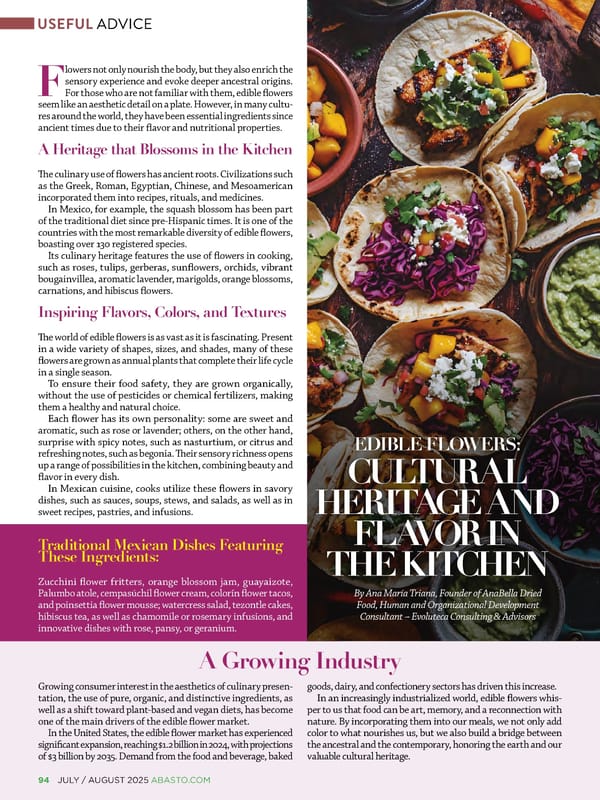EDIBLE FLOWERS: CULTURAL HERITAGE AND FLAVOR IN THE KITCHEN F lowers not only nourish the body, but they also enrich the sensory experience and evoke deeper ancestral origins. For those who are not familiar with them, edible flowers seem like an aesthetic detail on a plate. However, in many cultu- res around the world, they have been essential ingredients since ancient times due to their flavor and nutritional properties. A Heritage that Blossoms in the Kitchen The culinary use of flowers has ancient roots. Civilizations such as the Greek, Roman, Egyptian, Chinese, and Mesoamerican incorporated them into recipes, rituals, and medicines. In Mexico, for example, the squash blossom has been part of the traditional diet since pre-Hispanic times. It is one of the countries with the most remarkable diversity of edible flowers, boasting over 130 registered species. Its culinary heritage features the use of flowers in cooking, such as roses, tulips, gerberas, sunflowers, orchids, vibrant bougainvillea, aromatic lavender, marigolds, orange blossoms, carnations, and hibiscus flowers. Inspiring Flavors, Colors, and Textures The world of edible flowers is as vast as it is fascinating. Present in a wide variety of shapes, sizes, and shades, many of these flowers are grown as annual plants that complete their life cycle in a single season. To ensure their food safety, they are grown organically, without the use of pesticides or chemical fertilizers, making them a healthy and natural choice. Each flower has its own personality: some are sweet and aromatic, such as rose or lavender; others, on the other hand, surprise with spicy notes, such as nasturtium, or citrus and refreshing notes, such as begonia. Their sensory richness opens up a range of possibilities in the kitchen, combining beauty and flavor in every dish. In Mexican cuisine, cooks utilize these flowers in savory dishes, such as sauces, soups, stews, and salads, as well as in sweet recipes, pastries, and infusions. Traditional Mexican Dishes Featuring These Ingredients: Zucchini flower fritters, orange blossom jam, guayaizote, Palumbo atole, cempasúchil flower cream, colorín flower tacos, and poinsettia flower mousse; watercress salad, tezontle cakes, hibiscus tea, as well as chamomile or rosemary infusions, and innovative dishes with rose, pansy, or geranium. By Ana María Triana, Founder of AnaBella Dried Food, Human and Organizational Development Consultant – Evoluteca Consulting & Advisors Growing consumer interest in the aesthetics of culinary presen- tation, the use of pure, organic, and distinctive ingredients, as well as a shift toward plant-based and vegan diets, has become one of the main drivers of the edible flower market. In the United States, the edible flower market has experienced significant expansion, reaching $1.2 billion in 2024, with projections of $3 billion by 2035. Demand from the food and beverage, baked goods, dairy, and confectionery sectors has driven this increase. In an increasingly industrialized world, edible flowers whis- per to us that food can be art, memory, and a reconnection with nature. By incorporating them into our meals, we not only add color to what nourishes us, but we also build a bridge between the ancestral and the contemporary, honoring the earth and our valuable cultural heritage. A Growing Industry USEFUL ADVICE 94 JULY / AUGUST 2025 ABASTO.COM
 Abasto Magazine: July / August 2025 - ENGLISH Page 93 Page 95
Abasto Magazine: July / August 2025 - ENGLISH Page 93 Page 95